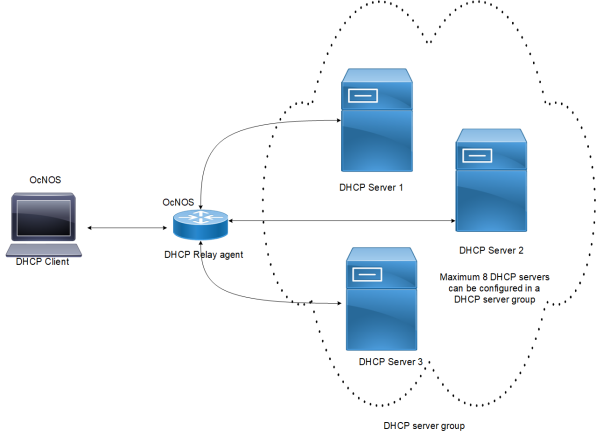DHCP Server Group
Overview
Dynamic Host Control Protocol (DHCP![]() Dynamic Host Configuration Protocol) Group provides the capability to specify multiple DHCP servers as a group on the DHCP relay agent
Dynamic Host Configuration Protocol) Group provides the capability to specify multiple DHCP servers as a group on the DHCP relay agent![]() A DHCP relay forwards the request from a DHCP client to the DHCP server group and takes the response from the DHCP server group to the DHCP client. and to correlate a relay agent interface with the server group. When the interface receives request messages from clients, the relay agent forwards the message to all the DHCP servers of the group. One or multiple DHCP servers in the group process the request and respond with an offer to the client. The client reviews the offer and sends the request message to the chosen server to obtain the network configuration that includes an IP address. The illustration below shows a DHCP client
A DHCP relay forwards the request from a DHCP client to the DHCP server group and takes the response from the DHCP server group to the DHCP client. and to correlate a relay agent interface with the server group. When the interface receives request messages from clients, the relay agent forwards the message to all the DHCP servers of the group. One or multiple DHCP servers in the group process the request and respond with an offer to the client. The client reviews the offer and sends the request message to the chosen server to obtain the network configuration that includes an IP address. The illustration below shows a DHCP client![]() A DHCP client is a hardware device or software that uses DHCP to get the network configuration information from a DHCP Server.
VRF: VRF creates a logically isolated routing table within a single physical network device. Each VRF instance works as an independent routing instance that enables separate network traffic, maintains different routing tables, and provides network isolation. sending a request message to a DHCP relay agent that forwards the message to the three servers in the DHCP server group to get their network configuration. The DHCP client and DHCP relay agent run OcNOS, but the DHCP servers can be OcNOS or Linux devices.
A DHCP client is a hardware device or software that uses DHCP to get the network configuration information from a DHCP Server.
VRF: VRF creates a logically isolated routing table within a single physical network device. Each VRF instance works as an independent routing instance that enables separate network traffic, maintains different routing tables, and provides network isolation. sending a request message to a DHCP relay agent that forwards the message to the three servers in the DHCP server group to get their network configuration. The DHCP client and DHCP relay agent run OcNOS, but the DHCP servers can be OcNOS or Linux devices.
Figure 1-1: DHCP server group

Feature Characteristics
This feature enables the configuration of the DHCP server group and attaches it to a DHCP relay agent through the CLI and the NetConf interface. A DHCP server group can be attached with multiple DHCP relay uplink interfaces, but at a given time, a single DHCP relay uplink interface is allowed to be attached with a single DHCP server group. The attachment of the DHCP relay uplink interface to another DHCP server group dissociates its attachment with the earlier attached DHCP server group.
This feature helps to configure DHCP IPv4 and IPv6 groups and attach server IP addresses to the group. Creating a maximum of 32 IPv4 and 32 IPv6 groups per VRF![]() Virtual Routing and Forwarding is allowed, and configuring 8 DHCP servers is permitted for each DHCP server group.
Virtual Routing and Forwarding is allowed, and configuring 8 DHCP servers is permitted for each DHCP server group.
Benefits
The DHCP relay agent forwards the request message from the DHCP client to multiple DHCP servers in the group. Forwarding the request message to multiple DHCP servers increases the reliability of obtaining the network configuration.